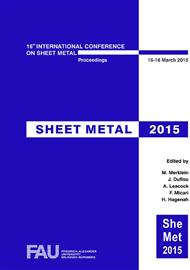p.99
p.107
p.115
p.123
p.131
p.139
p.147
p.155
p.163
Development of a New Method for Producing Plane Expanded Metal by Laser Cutting and Forming of Metal Plates under Uniaxial Tension
Abstract:
The on-going trend to lightweight construction leads to a special focus on plane lattice structures as an alternative for solid metal plates. They demonstrate similar mechanical properties while taking up only a fraction of the normal material input and are thus economically favourable. Additionally, they fulfil functional and design aspects and therefore are used by several industries like the automobile. Nevertheless, the two most common types of lattice structures – perforated metal plates and expended metal plates – are either waste intensive or uneven and hence require additional rolling of the metal plate.Therefore, within this contribution a new and innovative approach for the production of plane lattice structures will be presented. The manufacturing process thereby consists of two steps. At first, a specially designed pattern is cut into metal plates via a laser. Subsequently, the plates are formed under uniaxial tension to realize the lattice structures. Based on the cutting length, cutting space and the row space different blanks with tailored lattice structures can be produced. From the experimental results first guidelines for the design of suitable patterns are derived. The investigations will be performed with precipitation hardenable aluminium AA6014.
Info:
Periodical:
Pages:
131-136
Citation:
Online since:
March 2015
Authors:
Keywords:
Price:
Сopyright:
© 2015 Trans Tech Publications Ltd. All Rights Reserved
Share:
Citation:


